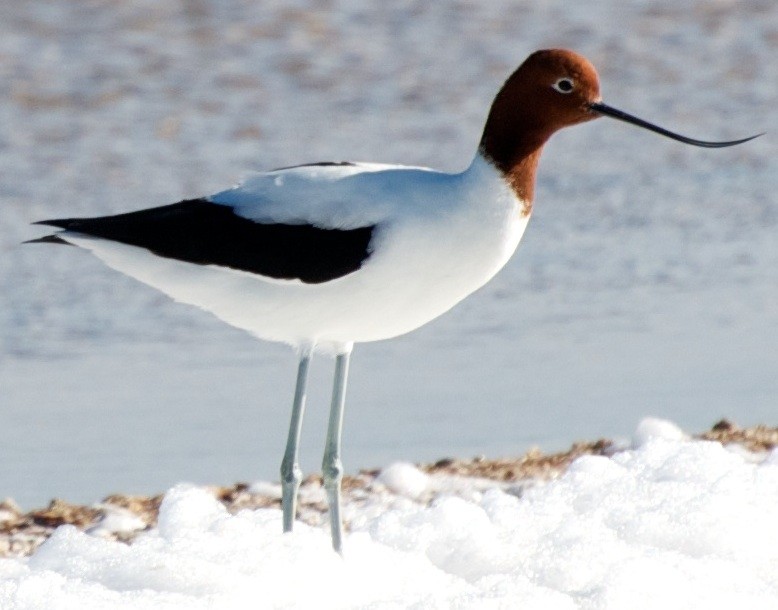Red-necked Avocet
A species of Avocets Scientific name : Recurvirostra novaehollandiae Genus : Avocets
Red-necked Avocet, A species of Avocets
Botanical name: Recurvirostra novaehollandiae
Genus: Avocets
Content
Description General Info
 Photo By Grahame , used under CC-BY-SA-2.0 /Cropped and compressed from original
Photo By Grahame , used under CC-BY-SA-2.0 /Cropped and compressed from original Description
The distinguishing feature of the red-necked avocet, and all avocet species, is the distinctive upcurved bill that is used for skimming the surface of water to catch small invertebrates. The adult's head and neck is a rich chestnut brown in colour (from which it derives its name) with a narrow white eye ring and a red-brown iris. The secondary coverts and primary feathers are black and the remainder of the plumage is white. The bill is black and the legs are a pale grey-blue. Both male and female are similar in colouring and size; neither is there seasonal variation in appearance. Juveniles are similar in appearance and difficult to identify once post-juvenile moult has started, the head is sometimes paler and browner that the adults. An average adult red-necked avocet measures 43–45 cm (17–17.5 in) from head to tail, and has a total wingspan of around 75 cm (29.5 in), wing length 22.4–23 cm, tail length 7.9–8.8 cm, and bill length of 8.2–9.5 cm, and weighs around 310 g. The call has been described as a yapping, and flocks in flight making a sound reminiscent of dogs barking. 
Size
48 cm
Nest Placement
Ground
Feeding Habits
Red-necked Avocet feed on small invertebrates like aquatic insects, larvae, and crustaceans, using their curved bills to sweep through water and mud. They also eat seeds and can upend in deep water for food. Juveniles peck at smaller prey until their bills mature.
Habitat
The red-necked Avocet primarily occupies shallow wetlands, showing a preference for saline or brackish environments in broader Australia, while being scarce in Tasmania and occasionally found in New Zealand. Their habitats include salt lakes, lagoons, marshes, and even sewage ponds, displaying adaptability to a range of salinity levels. As nomadic birds, they move according to rainfall variability, underscoring their resilience in diverse aquatic landscapes.
Dite type
Aquatic invertebrate eater
General Info
Feeding Habits
Bird food type
Behavior
Mainly found in loose colonies during the breeding season, the red-necked avocet disperses in small flocks for the rest of the year. Social in all activities and during all seasons, they are known to associate happily with stilts. Pre-mating courtship involves bill crossing and bowing dances with the female indicating their readiness to mate by crouching low with wings spread, this usually occurs in shallow water. Each pair defends their nesting territory with a range of displays and postures and will swoop repeatedly at intruders. Its voice is similar to other avocets, common calls include a fluty clear ‘tuut’ or ‘kluut’ that generally serves as a contact call with a shorter and sharper yelping notes reserved for warning calls. It can be fairly sedentary when in suitable conditions, though will quickly migrate towards coastal areas during dry weather. 
Distribution Area
Like many waterbirds found in Australia, the red-necked avocet is highly nomadic, due mainly to the high variation in rainfall, moving around the continent in search of suitable habitat. It has a very wide range in Australia but is comparatively rare on the northern and north-eastern coasts. The birds have a preference for salt or brackish water and are generally found in shallow wetland areas that are either fresh or salt, or on estuarine mudflats. The species is rare in Tasmania and an occasional vagrant to New Zealand. 
Species Status
Not globally threatened.
Scientific Classification
Phylum
Chordates Class
Birds Order
Shorebirds Family
Stilts and avocets Genus
Avocets Species
Red-necked Avocet